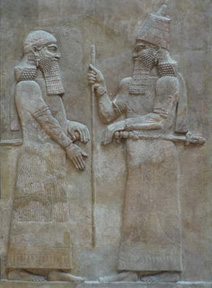Neo-Assyrian History Overview

Sargon II in conversation, probably with the crown prince Sennacherib. Stone orthostat from Façade L of the royal palace of Dūr-Šarrukīn (modern Khorsabad). Louvre, AO 19873-4. Photo by Karen Radner.
In the fourteenth–thirteenth centuries, during the reigns of Adad-nārārī I and his successors, Assyria first became a formidable military and political power. During the reign of Tiglath-pileser I (1114-1076 BC), Assyria's armies marched far afield from the Assyrian heartland, from Babylonia in the southeast to the Mediterranean Sea in the west. This king's victories on the battlefield were accompanied by profound economic and cultural advances. Assyria's greatness, however, did not last. It disappeared faster than it had been achieved. Pressure from encroaching Aramean tribal groups in the west and several successive years of bad harvests were major factors in Assyria's rapid decline. Until Aššur-dān II came to power during the second half of the tenth century BC (934-912 BC), Assyria was politically, militarily, and economically weak.
Under Aššur-dān II, Assyria once again flexed its military muscle and regained territory captured and held by the Arameans. A succession of one strong king after another not only brought Assyria back to the height of power that it had enjoyed under Tiglath-pileser I, but surpassed it. In the capable hands of Ashurnasirpal II (883-859 BC) and Shalmaneser III (858-824 BC), Assyria became the dominant political and military power in western Asia. Not only had Assyrian rulers successfully regained and reorganized all of the traditional "land of (the god) Aššur" (māt aššur), the very area that Tiglath-pileser I had directly controlled, but they also placed the "yoke of the god Aššur" on numerous foreign rulers, especially those in Syria and along the coast of the Mediterranean Sea, by extracting from them a heavy annual tribute. At home, the economy recovered and major building projects were sponsored, including the construction of a new administrative center: Kalḫu (biblical Calah; modern Nimrud).
The achievements of Shalmaneser III's two immediate successors, Šamšī-Adad V (823-811 BC) and Adad-nārārī III (810-783 BC), were relatively modest. Although both of these men undertook far-flung campaigns and carried out building projects at home, Assyria was suffering serious problems. The authority of the king declined, while that of prominent officials grew. The influence of some Assyrian officials was so great that they recorded their own names and deeds in official inscriptions in lieu of those of the king. While these men vied for power, Assyria's distant campaigns, as well as its victories on the battlefield, greatly decreased in scope and number. Thus, Assyria was relatively weak during the reigns of Shalmaneser IV (782-773 BC), Aššur-dān III (772-755 BC), and Aššur-nārārī V (754-745 BC). Assyria's fortunes, however, improved significantly during the reigns of its next six kings. During that time, Assyria would reach its political and cultural apex, with the kingdom expanding from deep into Iran in the east to the Levant and Egypt in the west, and from the Babylonian marshes in the south to the heartland of Anatolia in the north.
Click on the links to the left for further information about the kings whose inscriptions are edited by the RINAP Project.
Jamie Novotny
Jamie Novotny, 'Neo-Assyrian History Overview', The Royal Inscriptions of the Neo-Assyrian Period, The RINAP Project, 2019 [http://oracc.museum.upenn.edu/rinap/neoassyrianhistoryoverview/]